Warszawa II (15 page)
Authors: Norbert Bacyk

The Soviet 2nd Tank Army's armoured equipment, August 8, 1944
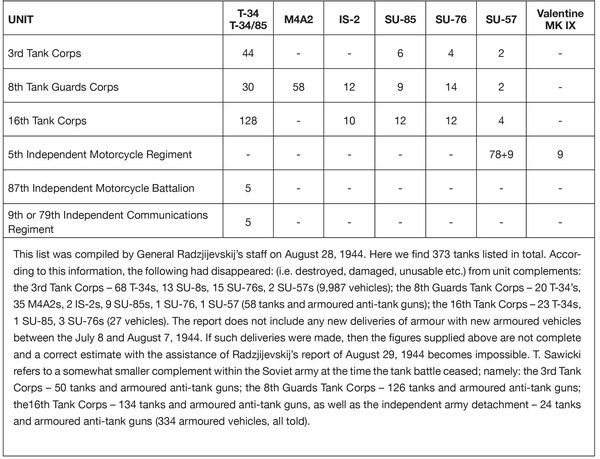
On August 10, the new Soviet offensive began. Before that day ended, the 5th SS-Panzer-Division “Wiking” reported no less than fifteen enemy attacks on StanisÅawów. These attacks were launched by General Popov's 47th Army and the 8th Guards Tank Corps. On this occasion it was Soviet fighter planes that dominated the airspace and attacks carried out by the Il-2 air attack wing covered the German positions with a rain of undirected rocket projectiles and gun fire. The 5th SS-Panzer-Division “Wiking” could not hold out on the battlefield and retreated back north, but, thanks to intense counterattacks conducted by SS-Panzer-Regiment 5, the situation stabilised during the evening. The next day, the IV SS-Panzer-Corps and the XX Army Corps' positions were attacked by units from the three infantry armies and three tank corps. The 47th Army, the 8th Guards Tank Corps and the 70thArmy's 3rd Tank Corps set off towards the new Waffen-SS Corps. The 28th Army attacked the XX Army-Corps in the area around SokoÅów Podlaski supported by tanks from the 9th Tank Corps, with the 2nd Guards Cavalry Corps held back in reserve.
The Germans withdrew, but the territory won cost the Soviet side heavy casualties. At the same time, the commander of the German 9th Army sent alarming reports concerning the critical supply-delivery situation facing his forces. The shortages primarily had to do with ammunition and fuel â shortages that were especially felt by the frontline entities (“Herman Göring”, 19th Panzer-Division and the new 4th Grenadier-Division) that had attacked the bridge emplacements at Magnuszew beginning on August 7, but the situation of the IV SS-Panzer- Corps wasn't much better. Model believed that the greatest threat to his plans lay at Magnuszew and therefore continued to send all available reserves there, which consequently led to the German fighting strength outside Praga being yet further weakened. The new German tanks were sent primarily to the bridge emplacements and it was Gille's corps that suffered as a result. For example, the 19th Panzer-Division improved its tank complement during the course of two weeks from 28 to 76 vehicles, despite being continuously engaged in combat. On top of this, on August 10 von Vormann took over command of Heeresgruppe “Nord Ukraine” XXXVI Panzer-Corps from General Smilo von Lüttwitz , but without being allotted any new troops. Lüttwitz took over command of the frontline extending from Radom to the discharge of the Pilica, and the VIII Army-Corps had the mission of defending the west bank of the Wisla from Pilica to Warsaw. General Höhne had only the resources of the 1132nd Grenadier-Brigade and the 23rd Luftwaffe-FLAK-Regiment to deploy along this stretch, but defended a 40 km. long frontline.
An armoured transport vehicle, model Sd Kfz 251/1 Ausf. C, from Panzer-Grenadier-Regiment 12, 4th Panzer-Division. The photo is probably taken during fighting in the vicinity of Radzymin during the first ten days of August 1944. (MWP)
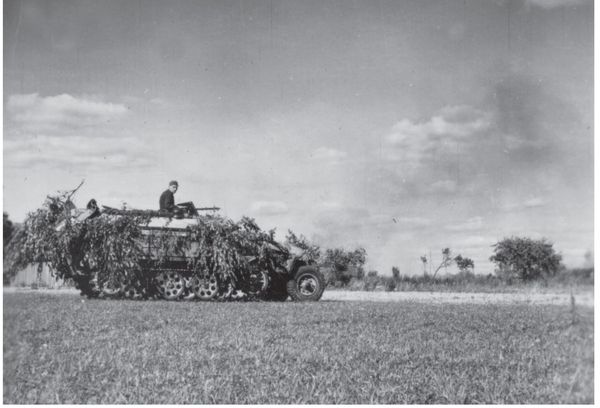
On August 12, Soviet troops launched yet another assault on the IV SS-Panzer-Corps and the XX Army-Corps. Having thoroughly prepared with artillery bombardment and an intense, almost compact, aerial attack; the infantry launched their assault with the support of tanks. The 47th Army which attacked from StanisÅawów toward TÅuszcz came under heavy fire.The Soviets brought the 8th Guards Tank Corps into battle. Between August 12-15, General Gusiev, commander of the 47thArmy, ordered repeated waves of attacks in an attempt to destroy the IV SS-Panzer-Corps' positions along the Okuniew-WoÅomin-TÅuszcz line. If successful, he would also effectively sever contact between the 9th and 2nd Armies as well as both corps defending the routes entering Warsaw. On August 15, after repeated bombardment in connection with air attacks by the IÅ-2 assault wing, the Soviet infantry entered WoÅomin and TÅusczc. The German and the west-European volunteers from the 5th SS-Panzer-Division “Wiking” responded with a series of heavy counter-attacks in which all of the tanks and assault-guns (StuG's) from both of the SS armoured regiments participated. Throughout the entire day, bloody close-quarter combat took place â including actual hand-to-hand use of the bayonet â and the 47th Army's two rifle corps retreated to their start-out positions. Troops from the IV SS-Panzer-Corps together with the XX Army-Corps managed to avoid being totally crushed. Nonetheless, between August 10 and 15; they were pressed back almost as far as the Bug. The front now ran precisely along the railway line between Warsaw and BiaÅystok. On the evening of August 15, they inflicted such heavy losses on the Soviet side that it ceased its assault, but this pause lasted only 48 hours. It was only along the stretch between Sulejówek and RadóÅc, on the direct approaches to Praga, that calm continued to reign.
An assault gun of model StuG 40 Sd Kfz 142/1 Ausf. G moving towards the eastern front, summer 1944. (CAW)
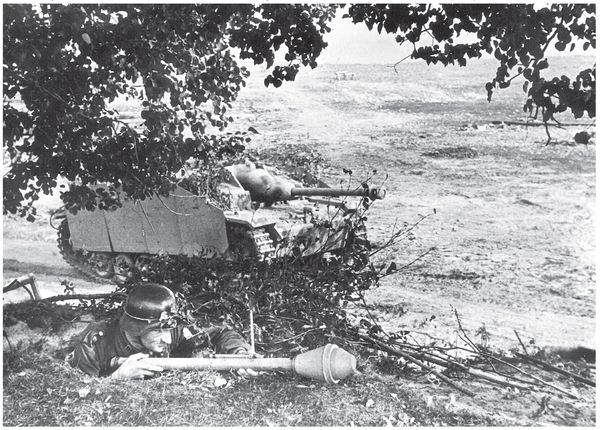
In the middle of August, vital changes were made in the command positions of the German side. Hitler was impressed by Model's effectiveness when it came to “taping” gaps in the front and was also highly aware of his dedication. For these two commendable reasons, he was awarded the prestigious post of Oberbefehlhaber “West” â commander in chief over all military forces in the west. Model would go on to organise the retreat of the defeated troops in Normandy over the Seine, simultaneously resolving sensitive political questions in the Wehrmacht staff related to lingering suspicions regarding his contacts with the July 20 conspirators. On August 16, General Georg Hans Reinhardt was appointed as the commander of Heeresgruppe “Mitte” â and General Josef Harpe was selected commander of Heeresgruppe “Nord Ukraine.” The Germans were very conscious of the weaknesses along their front, especially in the Warsaw region, therefore they decided to again send the Hungarian unit from the II Reserve Corps into combat. General von Vormann regarded this type of support as highly dubious, not just because their number was low and their weaponry light. His main objection was grounded in signs indicating they “fraternise with the Poles”, as he wrote of in his reports. Despite this, the Hungarian 12th Reserve Division took up combat positions between the Warsaw section of Å»oliborz and the Kampinos-reservation (to battle against the partisans), while the 5th Reserve Division reinforced the VIII Army-Corps outside Warsaw. These units began to regroup on August 19.
A day earlier in Warsaw (with the exception of the stretch of area passing through Praga), the 47th Army, the 70th Army, the 8th Guards Tank Corps, and the 28th Army resumed the assault directed against the IV SS-Panzer-Corps and the XX Army-Corps. The opposing German troop forces were as follows: along the RadoÅÄ-Solejówek line â the 73rd Infantry-Division; the Sulejówek-Ossów line â the 1131st Grenadier-Brigade; the WoÅomin-TÅuszcz line â the 3rd SS-Panzer-Division “Totenkopf”; in the TÅuszcz region â the 5th SS-Panzer-Division “Wiking” ; and along the Åochów-MaÅkinia line, in the following order â the 5th Jäger-Division, the 211th Infantry-Division and the 102nd Infantry-Division. Once again, the Soviet offensive was preceded by massive bombing runs and hurricanes of artillery fire. The main assault was carried out by the 70th and the 28th Armies between TÅuszcz and Åochów. The Soviet infantry with the support of tanks and assault guns overran the German positions at Jadów, just where the 5th SS-Panzer-Division “Wiking” and the 5th Jäger-Division connected. Without pause, the infantry continued their assault-march reaching the suburbs of TÅuszcz in hard fighting, with at least 400 armoured vehicles participating on the Soviet side alone.
The crew of a Soviet ZiS-3 firing against German tanks on the eastern front, August 1944.(WAF)
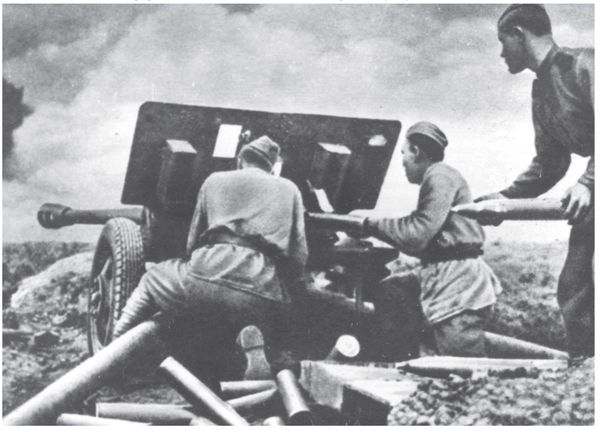
SS-Gruppenführer Herbert Gille received orders instructing him to conduct counter-attacks in the direction of Åochów. This was an impossible mission to execute since all the units in his corps were already engaged in battle. On that same day, August 18, SS-Panzer-Regiment 5 incurred heavy losses at Jadów, and the tanks which had been spared were sent speedily away in the direction of TÅusczc. Their presence made it possible for the soldiers from SS-Panzergrenadier-Regiment 9 “Germania” â exhausting the last of their strength â to hold back the enemy's attacks.
On August 19, the German front began to collapse. Attacking Soviet columns along the Liwiec River split both German corps and advanced to the Bug River. The 5th Jäger-Division had been destroyed. General Weià ordered a rapid evacuation of the XX Army-Corps to the other side of the Bug River, where he would take up new positions north of Wyszków. In other words, 2nd Army had withdrawn from Warsaw, and consequently, the entire burden of its defence was turned over to the 9th Army and the IV SS-Panzer-Corps.
A “Tiger” tank nr. 912 from the 9th SS-Panzer-Regiment “Totenkopf” in the Slupno region, August 1944. (Bundes Archive)
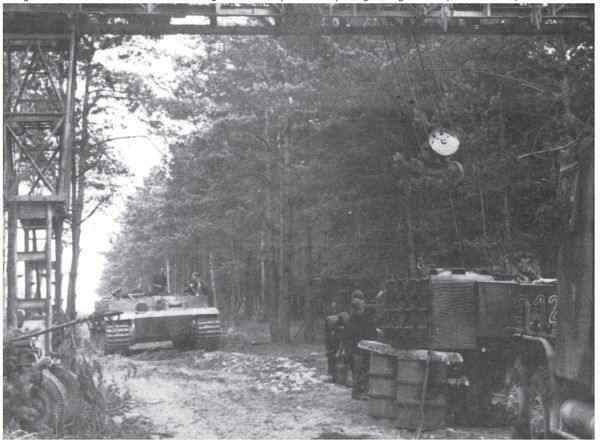
The west- European volunteers in the 5th SS-Panzer-Division “Wiking,” who were defending TÅuszcz at this time, found themselves under deadly bombardment from “Katjusha” rockets â the Soviet air force controlled the air, virtually unopposed. Wave after wave of infantry units and tanks washed over the unyielding defenders. The 47th Army stormed WoÅomin; and the 70th Army, TÅusczc. The 5th SS-Panzer-Division “Wiking” which fought on the left flank was forced to shorten its front to the TÅusczc and Wyszów line, and take up positions along the railway line there. That day, they successfully withstood the violent attacks against Wyszków by the 28th Army's frontline troops, solely thanks to a timely intervention carried out by all the panzer division's regiments. Tank crews reported enemy losses mounting to 20 destroyed tanks â on the other hand, SS-Panzer-Regiment 5 also lost two vehicles to the marsh-terrain near the village of Skuszew by the Bug. This sort of incident, where the Germans themselves blew-up their tanks after having become hopelessly trapped in the muddy banks of a river, would be repeated on further occasions,